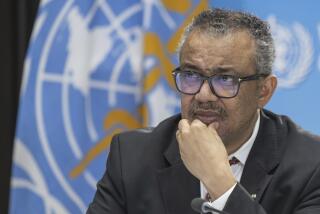AIDS Epidemic Worsening, Agency Finds : Health: Sharp increases in infections in Asia and Africa cited in new study.
- Share via
WASHINGTON — The global AIDS epidemic is worsening faster than experts earlier believed, according to new figures released Tuesday by the World Health Organization.
The organization predicted in 1988 that there would be a cumulative total of 15 million to 20 million adult AIDS infections by the year 2000. But in the last four years, substantial increases in infections in sub-Saharan Africa and South and Southeast Asia have suggested that the 15 million to 20 million total may be reached by the mid or late 1990s, the agency said in a report.
Recent information indicates, for example, that 3 million new infections have occurred in the past three to four years, most of them in these two regions, the health organization, a specialized U.N. agency, said.
Since last April--when WHO released its last report tracking the global spread of AIDS--more than 1 million new infections have occurred in the world, the organization said. “The world has seen what appeared at first to be an illness largely confined to homosexual men and drug injectors in industrialized countries become a pandemic affecting millions of men, women and children on all continents,” the report said.
WHO projected that a cumulative total of 30 million to 40 million adults and children will become infected with the human immunodeficiency virus by the turn of the century, meaning that infections will triple--or even quadruple--in the next eight years. (Cumulative total refers to the number of infections recorded since 1981, when the disease was identified.)
Dr. Anthony S. Fauci, the U.S. government’s top AIDS researcher, called the international numbers “disturbingly high but not surprising when you look at the numbers of people continuing to practice potentially risky behavior” in many of those countries. He blamed the escalating number of infections in part on a lack of international prevention programs.
Dr. Michael Merson, director of WHO’s global AIDS program, said that new prevention programs could still change the situation. “In absolute numbers, this is a wide range--30 million as opposed to 40 million people,” he said. “It means that aggressive prevention campaigns can make a real difference in the ultimate size of the pandemic. If we seize the opportunity, millions of people may be spared infection by the year 2000.”
Dr. June Osborn, who chairs the National Commission on AIDS and is a member of WHO’s Global Commission on AIDS, said she believes the projected numbers are conservative. “The dynamics of the epidemic in Asia have not yet been fully appreciated,” she said.
WHO estimates that 9 million to 11 million adults and 1 million children worldwide have become infected with HIV since 1981. Of these, about 1.5 million adults and 500,000 children have developed the disease--an increase of about 500,000 cases since last April.
In the United States, there has been a cumulative total of more than 200,000 cases. About 1 million people in this country are believed to be infected with the virus.
WHO said that the largest burden is being borne by the developing world, which already accounts for more than 80% of all HIV infections and is expected to have more than 90% of the infections by the year 2000. The distribution of AIDS cases is expected to follow the same pattern--but with a 10-year lag, since symptoms can take as long as 10 years after infection to develop.
More than 90% of the 1 million newly infected adults acquired their infection through heterosexual intercourse, WHO said. The vast majority of pediatric infections--children born to HIV-infected mothers--have occurred in sub-Saharan Africa, where more than 3 million women have become infected since the start of the pandemic. About one-third of all children born to infected mothers are themselves infected.
More to Read
Sign up for Essential California
The most important California stories and recommendations in your inbox every morning.
You may occasionally receive promotional content from the Los Angeles Times.













